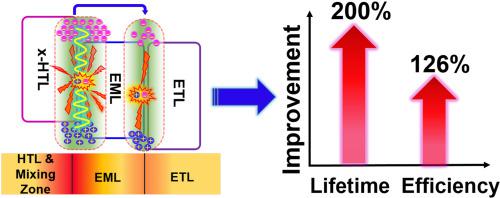Organic Electronics ( IF 2.7 ) Pub Date : 2021-09-17 , DOI: 10.1016/j.orgel.2021.106346 Thi Na Le 1 , Eun Young Park 1 , Vasudevan Thangaraji 1 , Min Chul Suh 1

|
It is known that the lifetime of the organic light-emitting diode device manufactured by the solution process is deteriorated due to the problem of mixing the interface between the hole transport layer and the emitting layer. We found that moving the recombination area away from the interface mixing zone as above doubled the efficiency (22.8 cd/A → 51.5 cd/A, 7.6% EQE → 14.6% EQE) and tripled the lifetime (14 h → 42 h). The reason was mainly attributed to the suppression of degradation due to exciton-polaron quenching at the mixing interface. Especially, the degradation of solution-processed devices has not been widely discussed. Therefore, in this study, we investigated thoroughly the deterioration of those devices by impedance spectroscopy and molecular simulation. The trap sites were revealed to present at the mixing zone when a large amount of charges accumulating there. These traps potentially resulted from the fragment of molecules undergoing the bond dissociation due to quenching of exciton and negative charge. Furthermore, by fitting Cole-Cole plots, we observed that the most stress region after half-lifetime test was the mixing zone. To confirm which molecules have a high possibility to dissociate, we calculated the bond dissociation energy of the possible dissociated bonds. The dissociation of host molecules from the anionic excited state due to quenching of exciton and negative polaron played the main role in device degradation. Meanwhile, the dissociation of hole transport molecules in the anionic charged states could also affect device lifetime by slow degradation.
中文翻译:

溶液加工 OLED 的使用寿命改善:激子形成区域的影响和阻抗谱的退化分析
已知通过溶液工艺制造的有机发光二极管器件的寿命由于空穴传输层和发光层之间的界面混合的问题而劣化。我们发现,将复合区移离界面混合区,效率提高了一倍(22.8 cd/A → 51.5 cd/A,7.6% EQE → 14.6% EQE),寿命延长三倍(14 h → 42 h)。其原因主要是由于混合界面处激子-极化子猝灭抑制了退化。特别是,溶液处理设备的退化尚未得到广泛讨论。因此,在这项研究中,我们通过阻抗谱和分子模拟彻底调查了这些设备的劣化。当大量电荷积聚在混合区时,显示出陷阱位置存在于混合区。这些陷阱可能是由于激子和负电荷的猝灭而发生键离解的分子片段造成的。此外,通过拟合 Cole-Cole 图,我们观察到半衰期测试后最大的应力区域是混合区。为了确认哪些分子有很高的解离可能性,我们计算了可能解离的键的键解离能。由于激子和负极极化子的猝灭,主体分子从阴离子激发态解离在器件退化中起主要作用。同时,阴离子带电状态中空穴传输分子的解离也可能通过缓慢降解影响器件寿命。这些陷阱可能是由于激子和负电荷的猝灭而发生键离解的分子片段造成的。此外,通过拟合 Cole-Cole 图,我们观察到半衰期测试后最大的应力区域是混合区。为了确认哪些分子有很高的解离可能性,我们计算了可能解离的键的键解离能。由于激子和负极极化子的猝灭,主体分子从阴离子激发态解离在器件退化中起主要作用。同时,阴离子带电状态中空穴传输分子的解离也可能通过缓慢降解影响器件寿命。这些陷阱可能是由于激子和负电荷的猝灭而发生键离解的分子片段造成的。此外,通过拟合 Cole-Cole 图,我们观察到半衰期测试后最大的应力区域是混合区。为了确认哪些分子有很高的解离可能性,我们计算了可能解离的键的键解离能。由于激子和负极极化子的猝灭,主体分子从阴离子激发态解离在器件退化中起主要作用。同时,阴离子带电状态中空穴传输分子的解离也可能通过缓慢降解影响器件寿命。此外,通过拟合 Cole-Cole 图,我们观察到半衰期测试后最大的应力区域是混合区。为了确认哪些分子有很高的解离可能性,我们计算了可能解离的键的键解离能。由于激子和负极极化子的猝灭,主体分子从阴离子激发态解离在器件退化中起主要作用。同时,阴离子带电状态中空穴传输分子的解离也可能通过缓慢降解影响器件寿命。此外,通过拟合 Cole-Cole 图,我们观察到半衰期测试后最大的应力区域是混合区。为了确认哪些分子有很高的解离可能性,我们计算了可能解离的键的键解离能。由于激子和负极极化子的猝灭,主体分子从阴离子激发态解离在器件退化中起主要作用。同时,阴离子带电状态中空穴传输分子的解离也可能通过缓慢降解影响器件寿命。由于激子和负极极化子的猝灭,主体分子从阴离子激发态解离在器件退化中起主要作用。同时,阴离子带电状态中空穴传输分子的解离也可能通过缓慢降解影响器件寿命。由于激子和负极极化子的猝灭,主体分子从阴离子激发态解离在器件退化中起主要作用。同时,阴离子带电状态中空穴传输分子的解离也可能通过缓慢降解影响器件寿命。











































 京公网安备 11010802027423号
京公网安备 11010802027423号